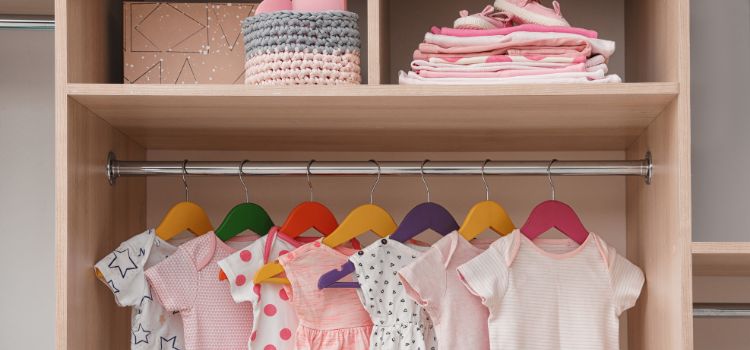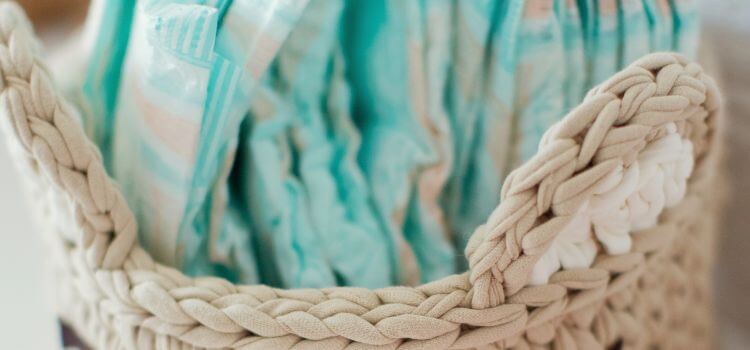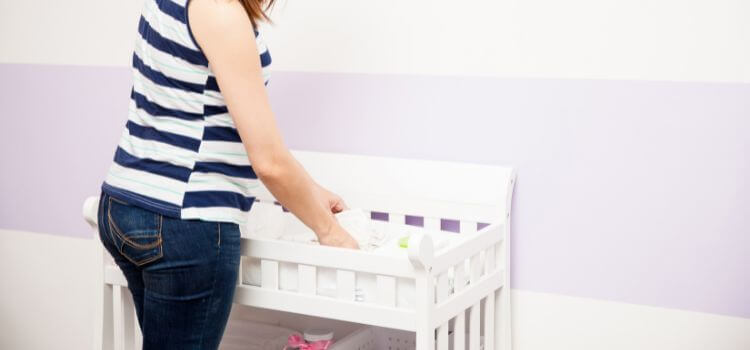
Diapers are essential in keeping babies comfortable and dry, leading them to happy, content children. But do you ever wonder how to store diapers correctly?
Whether you are a new or experienced parent, this guide will show you everything needed for storage so that when those messy moments arrive you’re always prepared.
Why Proper Diaper Storage Matters
Before diving in to discuss how to store diapers efficiently, let’s understand its significance. Proper diaper storage goes far beyond just keeping things organized.
It also ensures quality and hygiene standards are upheld. Here is why proper storage matters so much:
Retaining Diaper Quality
Diapers are made to be extremely absorbent, which will ensure that your baby remains dry and comfy. However, improper storage can compromise their absorbency.
Exposure to moisture, air, or sunlight can lead to the deterioration of the diaper’s core materials, reducing its effectiveness. By following our guidelines, you can ensure your diapers maintain their quality.
Preventing Contamination
Hygiene is paramount when it comes to diapering. Storing diapers incorrectly can expose them to dust, dirt, or even pests, leading to potential contamination.
This can result in skin irritations and discomfort for your baby. Proper storage safeguards your baby’s health and well-being.
Saving Money
Diapers can be expensive, and nobody wants to waste them due to improper storage. By implementing the right storage techniques, you can extend the lifespan of your diaper stash, ultimately saving you money in the long run.
How to Store Diapers Tips for Optimal Results
Now that we’ve established the importance of proper diaper storage, let’s explore practical tips to help you achieve optimal results.
Choose the Right Location
Selecting the right location for your diaper storage is the first step. Ideally, you want a cool, dry, and dark place. Avoid areas prone to direct sunlight, humidity, or extreme temperature fluctuations, as these can degrade diaper quality.
Invest in Quality Storage Solutions
Investing in quality diaper storage solutions can make a world of difference. Consider using airtight containers or resealable bags to keep diapers fresh and free from contaminants. These containers will also help maintain their absorbency.
Organize by Size
If your baby is still growing, organizing diapers by size is essential. This prevents you from accidentally using the wrong size diaper and ensures a snug fit, which is crucial for leak prevention.
Keep Them Dry
Moisture is the enemy of diaper storage. Ensure the storage area is dry and free from any potential leaks. If you’re using a diaper pail, clean and dry it regularly to prevent odors and moisture buildup.
Rotate Your Stock
To avoid using old diapers that may have lost some of their effectiveness, practice stock rotation. Use the oldest diapers first and replenish your stock accordingly. This way, you’ll always have fresh diapers on hand.
Store Diapering Accessories Nearby
In addition to storing diapers themselves, it’s a good idea to keep diapering accessories nearby. This includes wipes, diaper rash cream, and a changing pad.
Having everything within arm’s reach streamlines the diaper-changing process.
Label and Date
For maximum organization, consider labeling your diaper storage containers with the diaper size and the purchase date. This will help you keep track of your diaper inventory and ensure you use them before they expire.
10 Ways to Store Diapers in The Nursery With Style
Creating a stylish and organized nursery is every parent’s dream. When it comes to storing diapers in the nursery, you can blend functionality with aesthetics. Here are 10 stylish ways to store diapers in the nursery:

Diaper Caddy
A diaper caddy is a portable, stylish storage solution. Opt for a caddy with trendy colors or patterns that match your nursery decor. It can hold diapers, wipes, and other changing essentials.
Floating Shelves
Install floating shelves on the nursery wall and place stylish bins or baskets on them. They are not just for storage but also act as ornamental elements.

Dresser with Changing Topper
Invest in a dresser with a changing topper. This dual-purpose furniture piece combines a changing station with drawers for storing diapers, clothing, and other baby items.
Open Shelving Unit
Choose an open shelving unit with modern design elements. Display colorful diaper packages, storage bins, or decorative items on the shelves to add a pop of style.
Woven Baskets
Woven baskets are both functional and visually appealing. Place them on a bookshelf or in cubbies to store diapers neatly. Their natural texture adds warmth to the nursery.
Diaper Stacker
Opt for a stylish diaper stacker that matches your nursery’s theme or color scheme. Hang it near the changing table for easy access to diapers.
Under-Crib Storage
Make use of the space under the crib by adding storage bins or drawers. Choose sleek, modern containers that complement the crib’s design.
Wall-Mounted Organizers
Install wall-mounted organizers with pockets or shelves to hold diapers, wipes, and small nursery accessories. They can be practical and attractive.
Vintage Crates or Boxes
Vintage crates or decorative boxes can be used to store diapers. They add a touch of nostalgia and charm to the nursery.

Fabric Storage Bins
Fabric storage bins come in a variety of colors and patterns. Use them in open shelving units, on changing tables, or inside drawers to keep diapers organized and stylish.
Remember to keep safety in mind when choosing nursery storage solutions. Ensure that furniture is securely anchored, and small items are out of reach of curious little hands.
With these stylish diaper storage ideas, you can create a nursery that’s both functional and visually appealing, making diaper changes a breeze in a beautiful environment.
How to Store Dirty Cloth Diapers
Storing dirty cloth diapers properly is essential to maintain their cleanliness and prevent unpleasant odors. Here’s a step-by-step guide on how to store dirty cloth diapers:
Remove Solids: Before storing dirty cloth diapers, it’s essential to remove any solid waste. You can use a diaper sprayer or disposable liner to make this process easier. Shake or rinse off any excess waste into the toilet.
Wet Pail vs. Dry Pail: Cloth diapers may be stored in either a wet pail or a dry pail depending on which method best meets their storage requirements.
- Wet Pail: With the wet pail method, a pail or container filled with water mixed with diaper-safe solutions or detergent is filled and placed over dirty diapers that have been fully submerged – this prevents stain formation but must be used with caution as there may be risks involved such as drowning for curious toddlers.
- Dry Pail: In a dry pail method, you simply store the soiled diapers in a dry pail or a diaper bag without water. Make sure to shake off any excess waste and allow the diapers to air out before storing. This method is safer but may require more pre-treatment for stains.
Ventilation: Regardless of the storage method you choose, ensure there is proper ventilation to minimize odors. Leave the pail or diaper bag partially open or use a pail with a breathable lid.

Pre-treatment: For stubborn stains, pre-treating diapers before laundering could help. You could try pre-treating with either commercial stain removers such as lemon juice or baking soda or natural remedies like lemon juice and baking soda. Always follow manufacturer directions with any stain remover.
Store in a Cool, Dry Place: If you cannot wash diapers immediately, store them in a cool and dry location away from direct sunlight and in an environment without excessive heat or humidity. These conditions could foster bacteria growth that leads to unpleasant odors and infections.
Options for storing dirty cloth diapers before washing
When it comes to storing dirty cloth diapers, there are several options to choose from, depending on your preferences and the space available.
Proper storage is important to minimize odors and make the diaper-cleaning process more manageable. Here are some common options:
Wet Pail Method
This method involves storing soiled cloth diapers in a pail filled with water. Some parents add a diaper pail liner to make cleanup easier.
Dry Pail Method
With this method, you store dirty cloth diapers in a dry pail or wet bag without water. You can use a dry pail liner for easy transport to the laundry.
Conclusion
Choose the storage method that meets your individual needs, lifestyle, and space constraints best. Whatever method you opt for, making sure to incorporate regular washing routines and using detergents designed specifically to clean cloth diapers regularly are necessary to keep them odor-free and looking their best!
Frequently Asked Questions How to Store Diapers
How many diapers should I store at once?
Maintain a supply of at least seven diapers on hand – babies can go through many more diapers each day! By having some spare, you will always be prepared for their changing needs.
Do I need to store cloth diapers differently?
Yes, cloth diapers require special care. Store dirty cloth diapers in a designated bin with a lid to contain odors, and wash them promptly to prevent staining.
How can I tell if diapers have gone bad?
If diapers have an unusual odor, appear discolored, or feel brittle, they may have gone bad. It’s best to replace them to ensure your baby’s comfort.

Pingback: Where Can I Exchange Diapers Without Receipt? Parents Guide
Pingback: How to Use Reusable Swim Diapers? Reusable Diaper Guide
Pingback: The 7 Best Prefold Cloth Diapers (2024)
Pingback: How to Tell Where Diapers Were Purchased? Parenting and Baby Care 1
Pingback: 70+Long Baby Girl Names | Beautiful With Meaning
Pingback: What to Do with Unused Diapers? Creative Solutions